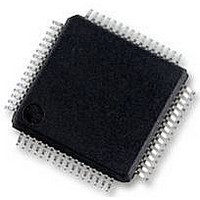S9S12HY64J0MLH Freescale Semiconductor, S9S12HY64J0MLH Datasheet - Page 473

S9S12HY64J0MLH
Manufacturer Part Number
S9S12HY64J0MLH
Description
MCU 64K FLASH AUTO 64-LQFP
Manufacturer
Freescale Semiconductor
Series
HCS12r
Datasheet
1.S9S12HA32J0CLL.pdf
(792 pages)
Specifications of S9S12HY64J0MLH
Core Processor
HCS12
Core Size
16-Bit
Speed
32MHz
Connectivity
CAN, EBI/EMI, I²C, IrDA, LIN, SCI, SPI
Peripherals
LCD, Motor control PWM, POR, PWM, WDT
Number Of I /o
50
Program Memory Size
64KB (64K x 8)
Program Memory Type
FLASH
Eeprom Size
4K x 8
Ram Size
4K x 8
Voltage - Supply (vcc/vdd)
4.5 V ~ 5.5 V
Data Converters
A/D 6x10b
Oscillator Type
Internal
Operating Temperature
-40°C ~ 125°C
Package / Case
64-LQFP
Controller Family/series
S12
No. Of I/o's
50
Ram Memory Size
4KB
Cpu Speed
64MHz
No. Of Timers
2
Rohs Compliant
Yes
Processor Series
S12HY
Core
HCS12
3rd Party Development Tools
EWHCS12
Development Tools By Supplier
DEMO9S12HY64
Lead Free Status / RoHS Status
Lead free / RoHS Compliant
Available stocks
Company
Part Number
Manufacturer
Quantity
Price
Company:
Part Number:
S9S12HY64J0MLH
Manufacturer:
Freescale Semiconductor
Quantity:
10 000
- Current page: 473 of 792
- Download datasheet (4Mb)
13.4.2
The SPI operates in slave mode when the MSTR bit in SPI control register 1 is clear.
Freescale Semiconductor
•
•
•
If MODFEN is set and SSOE is cleared, the SS pin is configured as input for detecting mode fault
error. If the SS input becomes low this indicates a mode fault error where another master tries to
drive the MOSI and SCK lines. In this case, the SPI immediately switches to slave mode, by
clearing the MSTR bit and also disables the slave output buffer MISO (or SISO in bidirectional
mode). So the result is that all outputs are disabled and SCK, MOSI, and MISO are inputs. If a
transmission is in progress when the mode fault occurs, the transmission is aborted and the SPI is
forced into idle state.
This mode fault error also sets the mode fault (MODF) flag in the SPI status register (SPISR). If
the SPI interrupt enable bit (SPIE) is set when the MODF flag becomes set, then an SPI interrupt
sequence is also requested.
When a write to the SPI data register in the master occurs, there is a half SCK-cycle delay. After
the delay, SCK is started within the master. The rest of the transfer operation differs slightly,
depending on the clock format specified by the SPI clock phase bit, CPHA, in SPI control register 1
(see
Serial clock
In slave mode, SCK is the SPI clock input from the master.
MISO, MOSI pin
In slave mode, the function of the serial data output pin (MISO) and serial data input pin (MOSI)
is determined by the SPC0 bit and BIDIROE bit in SPI control register 2.
SS pin
The SS pin is the slave select input. Before a data transmission occurs, the SS pin of the slave SPI
must be low. SS must remain low until the transmission is complete. If SS goes high, the SPI is
forced into idle state.
The SS input also controls the serial data output pin, if SS is high (not selected), the serial data
output pin is high impedance, and, if SS is low, the first bit in the SPI data register is driven out of
the serial data output pin. Also, if the slave is not selected (SS is high), then the SCK input is
ignored and no internal shifting of the SPI shift register occurs.
Although the SPI is capable of duplex operation, some SPI peripherals are capable of only
receiving SPI data in a slave mode. For these simpler devices, there is no serial data out pin.
Slave Mode
Section 13.4.3, “Transmission
A change of the bits CPOL, CPHA, SSOE, LSBFE, XFRW, MODFEN,
SPC0, or BIDIROE with SPC0 set, SPPR2-SPPR0 and SPR2-SPR0 in
master mode will abort a transmission in progress and force the SPI into idle
state. The remote slave cannot detect this, therefore the master must ensure
that the remote slave is returned to idle state.
MC9S12HY/HA-Family Reference Manual Rev. 1.04
Formats”).
NOTE
Serial Peripheral Interface (S12SPIV5)
473
Related parts for S9S12HY64J0MLH
Image
Part Number
Description
Manufacturer
Datasheet
Request
R
Part Number:
Description:
Manufacturer:
Freescale Semiconductor, Inc
Datasheet:
Part Number:
Description:
Manufacturer:
Freescale Semiconductor, Inc
Datasheet:
Part Number:
Description:
Manufacturer:
Freescale Semiconductor, Inc
Datasheet:
Part Number:
Description:
Manufacturer:
Freescale Semiconductor, Inc
Datasheet:
Part Number:
Description:
Manufacturer:
Freescale Semiconductor, Inc
Datasheet:
Part Number:
Description:
Manufacturer:
Freescale Semiconductor, Inc
Datasheet:
Part Number:
Description:
Manufacturer:
Freescale Semiconductor, Inc
Datasheet:
Part Number:
Description:
Manufacturer:
Freescale Semiconductor, Inc
Datasheet:
Part Number:
Description:
Manufacturer:
Freescale Semiconductor, Inc
Datasheet:
Part Number:
Description:
Manufacturer:
Freescale Semiconductor, Inc
Datasheet:
Part Number:
Description:
Manufacturer:
Freescale Semiconductor, Inc
Datasheet:
Part Number:
Description:
Manufacturer:
Freescale Semiconductor, Inc
Datasheet:
Part Number:
Description:
Manufacturer:
Freescale Semiconductor, Inc
Datasheet:
Part Number:
Description:
Manufacturer:
Freescale Semiconductor, Inc
Datasheet:
Part Number:
Description:
Manufacturer:
Freescale Semiconductor, Inc
Datasheet:











